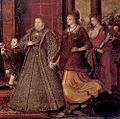Early modern Europe facts for kids
The early modern period is a term used by historians for the period in Western Europe and its first colonies which spans the three centuries between the Middle Ages and the Industrial Revolution.
The early modern period is characterized by the rise to importance of science and technological progress, civic politics and the nation state. Capitalism began its rise, beginning in northern Italian republics such as Genoa. The early modern period also saw the rise and dominance of the economic theory of mercantilism. As such, the early modern period represents the decline and eventual disappearance, in much of the European sphere, of feudalism, serfdom and the power of the Catholic Church.
The period includes the Protestant Reformation, the Thirty Years' War, the European colonization of the Americas and the peak of the European hunt of witches.
The beginning of the early modern period is not clear-cut, but is generally accepted to be in the late 15th century or early 16th century. Significant dates in this phase from medieval to early modern Europe are:
- 1447
- The invention of the first European movable type printing press by Johannes Gutenberg, a device that fundamentally changed the circulation of information. Movable type, which allowed individual characters to be arranged to form words and which is an invention separate from the printing press, had also been invented in, but not known outside of, China.
- 1453
- The conquest of Constantinople by the Ottomans signalled the end of the Byzantine Empire; the Battle of Castillon meant the end of Hundred Years' War.
- 1485
- England
- The last Plantagenet king, Richard III, was killed at Bosworth and the medieval civil wars of aristocratic factions gave way to early modern Tudor monarchy, in the person of Henry VII.
- England
- 1492
- Spain
- The first documented European voyage to the Americas by the Italian explorer Christopher Columbus; the end of the Reconquista, with the final expulsion of the Moors from the Iberian Peninsula; the Spanish government expels the Jews.
- Spain
- 1494
- France
- Italy
- French king Charles VIII invaded Italy, so he started a series of wars which are typical for the Italian Renaissance.
- 1513
- First formulation of modern politics with the publication of Machiavelli's The Prince.
- 1517
- The Reformation begins with Martin Luther nailing his ninety-five theses to the door of the church in Wittenberg, Germany.
- 1545
- The Council of Trent marks the end of the medieval Roman Catholic Church.
The end date of the early modern period is associated with the Industrial Revolution, which began in Britain in about 1750, or the beginning of the French Revolution in 1789, which drastically transformed the state of European politics.
Among the most important political changes of this time are the abolition of serfdom and the change of kingdoms into nation-states. Then the Reformation, that meant that Christendom was no unified entity any more. Many kings and rulers used this radical shift in the understanding of the world to further consolidate their sovereignty over their territories. For instance, many of the Germanic states (as well as English Reformation) converted to Protestantism in an attempt to slip out of the power of the Pope.
The intellectual developments of the period included the creation of the economic theory of mercantilism and the publication of works of political and social philosophy, such as Machiavelli's The Prince (1513) and Thomas More's Utopia (1515).
Contents
Difference between 'early modern' and the Renaissance
The expression "early modern" is sometimes, and incorrectly, used as a substitute for the term Renaissance. However, "Renaissance" is properly used in relation to a diverse series of cultural developments; which occurred over several hundred years in many different parts of Europe—especially central and northern Italy—and span the transition from late Medieval civilization and the opening of the early modern period.
The term early modern is most often applied to Europe, and its overseas empire. However, in Japan, the Edo period from 1590 to 1868 is also sometimes referred to as the early modern period.
Political powers
Related pages
Images for kids
-
Abraham Ortelius: Map of Europe, 1595
-
Henry VIII broke England's ties with the Catholic Church, becoming the sole head of the English Church.
-
After the Peace of Westphalia in 1648, Europe's borders were largely stable. 1708 map by Herman Moll
-
Treaty of Westphalia allowed Calvinism to be freely exercised.
-
Elizabeth ushers in Peace and Plenty. Detail from The Family of Henry VIII: An Allegory of the Tudor Succession, c. 1572, attributed to Lucas de Heere.







